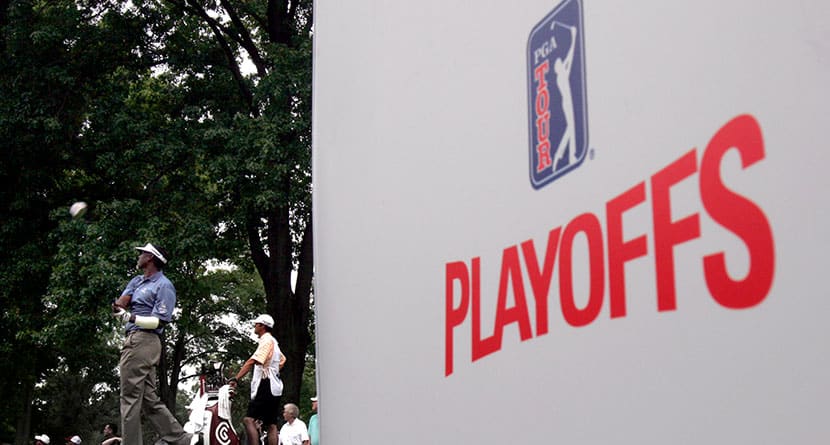MEMPHIS, Tenn. (AP) — The poster in the Memphis International Airport declares that “the playoffs start here,” except that it includes a picture of Justin Thomas. He only wishes he were here.
That speaks to the meritocracy in golf, and that’s not going away.
Neither is privilege, which is why Thomas should only be fretting about a spot on the Ryder Cup team, not whether there will be room for him at Riviera and Quail Hollow.
Thomas and Adam Scott are among six players who were in the FedEx Cup finale at East Lake last year and didn’t even make it to the starting line for the playoff opener at TPC Southwind, now for the top 70 players instead of the top 125. Scott had never missed the PGA Tour’s postseason since the FedEx Cup began in 2007.
So the notion the new model for the PGA Tour is built around big-money tournaments that cater only to the big names in golf is missing a key element: It still requires good golf.
Good golf came from Canadian Open champion Nick Taylor and U.S. Open champion Wyndham Clark. It came from two-time winner Keegan Bradley, the resurgent Rickie Fowler, from Adam Schenk and Taylor Moore.
All of them are assured of being among the top 50 who are guaranteed spots in the eight “signature events” with $20 million purses. They earned that right alongside perennial stars like Jon Rahm, Rory McIlroy and Scottie Scheffler.
Thomas was on that list of stars until this year when so much went wrong. And if the playoffs always had been restricted to the top 70 players, the likes of Fowler, Jordan Spieth and Brooks Koepka (before he went to LIV Golf) also would have been left out some years.
And just like Thomas, none of them would have anything to worry about because of four sponsor exemptions for the signature events. That’s the PGA Tour’s version of a safety net, and a hole in the concept of meritocracy.
Here’s where meritocracy still works. Anyone who keeps full PGA Tour status can still get into the biggest and richest tournaments. They can still make their way to the postseason, all the way to the Tour Championship in East Lake.
One of the sticking points that came out of the infamous Delaware meeting last year that began to revamp the PGA Tour was keeping avenues open to everyone.
J.T. Poston said it best at the start of the year, before anyone knew details of how these $20 million tournaments would work and whether it was all about taking care of the big names.
“As long as there’s a way they still have to perform to stay in, and there’s an avenue for guys that aren’t in to play their way in, I don’t think there’s an issue,” Poston said at Kapalua.
That much was solved with 15 additional spots in each of the signature events. Ten of those spots were from the leading players not already exempt from the FedEx Cup (the 2023 list for two signature events, the 2024 list for the rest of them). The other five come from a special points list of tournaments that take place between the signature events.
If players have a tee time, they have a chance. That’s how golf is meant to work and still does on the PGA Tour.
The issue is the four sponsor exemptions.
Thomas is getting plenty of attention these days, perhaps because it’s so surprising he missed the playoffs, and partly because of how his season ended — a perfectly played pitch that kissed off the base of the pin on the final hole of the regular season and stayed out.
He has little reason to worry about being left out of the Genesis Invitational at Riviera or the Wells Fargo Championship at Quail Hollow or the Memorial or any other $20 million event because what tournament wouldn’t want him?
Thomas might not even need them if he stays in the top 30 in the world ranking, another exemption into the signature events.
But if the PGA Tour has set hard and fast rules — Thomas missed the playoffs by nine FedEx Cup points — there’s no reason to create more spots for those who didn’t perform. Because then it runs the risk of becoming a popularity contest.
“I voiced this when it came up — I wasn’t in favor of those tournaments having invites or exemptions, however you want to call it,” Rahm said. “Everybody that’s played has earned it one way or another. To get an exemption, you just don’t want it to go to somebody who for whatever reason they liked.”
Rahm relied on sponsor exemption to earn his PGA Tour card in roughly three starts after he turned pro in the summer of 2016. So did Tiger Woods, among others. Those are for players on the rise, out of college or just making their way.
The PGA Tour has never been tougher, especially now that only 70 players — less than half the players who start a new season with full status — make it to the postseason and only 50 are guaranteed spots in the big events.
Throw in the eight signature events, and the idea was for the best players to compete against each other more often, not just in the majors. Players still should have to earn that right, or work their way back if they don’t.
One solution would be to limit the number of sponsor exemptions a player can accept to the signature events. If wealth isn’t to be earned, it wouldn’t hurt to share it.




